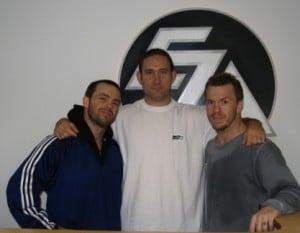
Recently, there has been a sudden shift from the once poplular and often prescribed high intensity interval training to at least a greater appreciation and understanding of the aerobic system and its contribution to elite physical conditioning and game preparation. At the heart of this subject matter is none other than Joel Jamieson - BSMPG 2012 Summer Seminar Speaker.
Learn more from Joel along with a number of the country's top performance coaches at the 2012 BSMPG Summer Seminar. But don't wait - seats are limited and this event is sure to sell out again this year!
Excerpt from:
ULTIMATE MMA CONDITIONING-Joel Jamieson
Method #5 Threshold Training
At the beginning of this chapter, I told you that it was important to increase how much power you could generate aerobically so that you had to rely less on fatiguing anaerobic processes to generate the necessary ATP. The threshold training method is very effective at helping you increase your aerobic power and achieve this goal. The basic premise of the method is very simple, by working your aerobic system to the maximum limits of its energy production abilities, the body adapts by increasing the total number of aerobic enzymes and improving overall contractile properties. As a result, the maximum rate of aerobic energy production increases.
If you’ll recall from earlier, the point where your body begins to shift the majority of its ATP generation from aerobic to anaerobic is known as the anaerobic threshold. This is a very important point because it reflects the maximum sustainable output that your aerobic system is capable of. If we can raise your anaerobic threshold and/or increase your power output at the threshold, then you’ll have to rely less on the anaerobic systems and you’ll have better endurance.
Although there is definitely some genetic influence that determines where your anaerobic threshold is, it’s also a very trainable quality because we can dramatically increase how much power you’re able to produce aerobically through the proper training methods. Threshold training is one of the methods and consists of training at heart rates at or near your anaerobic threshold for different periods of time. Because you are essentially asking your body to produce ATP as fast as it possibly can while predominantly using the aerobic system, this method places a great deal of stress on the entire system and provides a strong stimulus for it to improve. This is one of the reasons it is so effective, but it also means you have to be fairly precise in determining your threshold.
For maximum effectiveness, you want to train in a heart range that is within +/- 5 bpm of your anaerobic threshold. Unfortunately, there is no simple and easy way for most people to determine where their anaerobic thresholds are exactly. The most accurate way is through a gas exchange test done at an exercise performance lab, but this is obviously impractical for most people. If you have access to a metabolic testing center in your area, this can offer an effective way to determine your threshold and it typically runs between $75 and $125 for the test.
Aside from using a laboratory testing procedure, it can be difficult to get an accurate gauge of where exactly your anaerobic threshold is. The next best alternative is to use a simple test I came up with and perform 3x5 minute sparring rounds at a relatively high pace with a heart rate monitor on. If you don’t spar, then you can do 3x5 minute pad rounds or something comparable such as the modified coopers test as described in a later chapter.
For the test, you will need to use a heart rate monitor with a lap function and I specifically recommend the Polar RS100 for this purpose. If you don’t have one of these yet you can order one directly from my website at www.8weeksout.com. All you have to do is record your average heart rate for each of the three rounds, excluding the 60s break between rounds, and take your average heart rate over the entire 3 rounds. While there is no research on this approach to show it accurately reflects your anaerobic threshold, I’ve found it to be reasonably close for most people and it is much better than just guessing.
Once you have found your average heart rate over the three rounds, this is the heart rate number you should use for the threshold training method. To use the threshold method, all you have to do is keep your heart rate at +/- 5 bpm for repetitions of 3-10 minutes at a time using different types of exercises. Many athletes use this method in the form of circuit style training, although they rarely pay attention to where their heart rate is during the circuit. You can use running, MMA drills and sparring, cycling, etc. But keep in mind you’ll need to lower your heart rate range by 5-10 bpm in activities where you are sitting or lying down.



